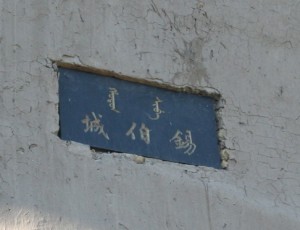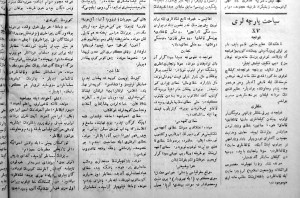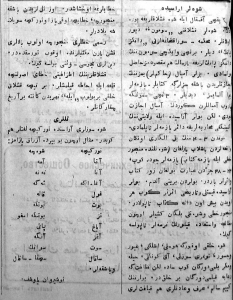David Brophy, Postdoctoral Fellow, Australian Centre on China in the World
Between 1915 and 1917, the Tatar journalist Nushirvan Yavshef undertook a trip to Xinjiang, or Chinese Turkistan (Chīnī Türkistān) as he usually called it. The first leg took him from Russian-held Semirech’e up the Ili Valley to Ghulja, then to Ürümchi and Turfan. From there he headed south via Kucha to Kashgar, and along the oases of the southern Tarim Basin as far as the remote village of Keriyä. His first reports from this journey were published in the Tashkent newspaper Voice of Turkistan (Ṣadā-yi Turkistān). Later dispatches appeared in the Tatar daily Time (Vaqıt) and the fortnightly journal Council (Shūrā), both published in Orenburg. Nushirvan Yavshef passed away in Tashkent in 1917 shortly after returning from Xinjiang, and thus failed to fulfil his ambition to edit his many articles into a book.
Although concerned primarily with the plight of the Turkic-speaking Muslims of Chinese Turkistan (the Uyghurs), Nushirvan Yavshef was a curious and engaged traveller. Among the many vignettes that his writings offer of life in Xinjiang in this period, is an account of his trip to the Sibe villages of the Ili Valley, translated below.
During his stay in the Muslim town of Ghulja (Yining 伊寧), Yavshef poked around for historical records. Locals directed him to the Sibe living further down the Ili River, whose territory is now designated as the Chapchal Sibe Autonomous County 察布查爾錫伯族自治縣. The Sibe Yavshef found there were a well-read community, with books in every household. He eventually gained the necessary permission to browse documents in the local archives (contemporary researchers will sympathise with his difficulties), but failed to find the information on recent events that he was looking for.
Men like Yavshef were participants in an ongoing questioning of identity among Russian Muslims, one that proposed racial and linguistic affinities among not only the Turkic-speaking peoples of the world, but stretching to “Altaic” groups such as the Mongols and the Manchus. The Manchus were, after all, frequently referred to by outsiders as “Tartars,” and it was not uncommon for educated Tatars in those days to think of the Manchus in China as in some sense their ethnic brethren. During his trip to the Sibe, Yavshef therefore indulged his linguistic curiosity, and tried to identify Turki words among the lexicon of the Sibe he met.
Yavshef was a better journalist than he was a linguist. Most of his lexical comparisons between Turki and Sibe are unconvincing. But that is not really the point. Yavshef’s piece belongs to a tradition of popular writing on the Manchus, and the Sibe, that commenced during the late Qing and continues to this day, offering glimpses of village life and local religion, and
preserving fragments of spoken Manchu. In the case of the Sibe at least, Yavshef in 1915 might well be considered a pioneer of the genre.
Source: “Snapshots from a Trip, Part 15 (Sayāhet parcheleri XV)” Voice of Turkistan, September 2, 1915, pp. 2-3.
***
In the Company of the Aʿlam Akhund
They call the chief judge here the “aʿlam akhund” [lit. “most learned akhund”]. The name of the aʿlam akhund is Ibrahim. Ibrahim Akhund is an open-minded man, and far from opposing the activities of the progressive youth, he gives them support and encouragement.
I asked him for historical information about affairs in Chinese Turkistan.
He said: “Among us Muslims those kinds of historical works don’t exist, but something like this might be found among the Sibe [Shive]. The place where most of them live is down the Ili River, in the villages. I’ll write a letter to the aqsaqal [village head], he’ll take you to the Sibe villages.”
Among the Sibe
 I went with Baqchi Aqsaqal to the Sibe villages. The Sibe call a village “sumun”,[1] and the administrative buildings the “Dangz pang”.[2] When we went to the Dangz Pang of the first and second sumun, we didn’t find what we were looking for. The amban told us: “without permission from our superiors we can’t give you any books or manuscripts.” Then we went to the third sumun, and the amban who was in charge of the other ambans gave us his permission, but there were no records to be found about the recent fighting in the Ili district.[3]
I went with Baqchi Aqsaqal to the Sibe villages. The Sibe call a village “sumun”,[1] and the administrative buildings the “Dangz pang”.[2] When we went to the Dangz Pang of the first and second sumun, we didn’t find what we were looking for. The amban told us: “without permission from our superiors we can’t give you any books or manuscripts.” Then we went to the third sumun, and the amban who was in charge of the other ambans gave us his permission, but there were no records to be found about the recent fighting in the Ili district.[3]
There are a lot of books about past events, starting from three or four thousand years ago (these are books written in the Sibe language in the Manchu script). There are some very large books, consisting of between twenty-two and sixty-eight volumes. I bought one of these. There are a lot of valuable historical works around—in every household five or ten items can be found. For people who know Manchu script and the Sibe language, there should be things here that can be utilised.
The Sibe people are interested in reading. They are a hardworking, proud and uncompromising folk, correct in speech, open-hearted, and not at all deceitful, though they aren’t particular about cleanliness. Their clothes, customs and physical appearance are the same as the Chinese. Apart from their own language, they know how to read and write in Manchu and Chinese, and they also speak Turki [i.e. Uyghur].
Their official script is Manchu, and their children study throughout the winter and summer. I suppose that their religion is that of the fire-worshippers and idolaters [mājūsī–wasanī].
The edges of the village are surrounded by fortifications in Chinese style. The people belonging to several different villages collaborated to dig a large canal from the Ili River.
Their Language
There are a lot of Turki words in the Sibe vocabulary. I will list a few here as examples:
|
Turki |
Sibe |
English | Manchu | ||
|
آتا |
ata |
آمه |
ama | father | ama |
|
آنا |
ana |
نهنه |
nene | mother | eniye |
|
آغا اکه |
agha-eke |
ئهگه |
ege | brother | age? |
|
قول |
qol |
قاله |
qala | hand | gala |
|
بوت |
but |
بوتکه |
botke[4] | leg | bethe |
|
تز |
tiz |
بوتکه امغو |
botke amghu | knee | bethe ? |
|
آیاغ |
ayagh |
پاتی |
pati | foot | ? |
|
آغز |
aghız |
آنگه |
anga | mouth | angga |
|
سوت |
süt |
سوانك |
suwang | milk | sun |
|
ساقال |
saqal |
سچقا-ساقال |
sachqa-saqal | beard | salu |
And there are others.
– Nushirvan Yavshef.
***
I have added my own Latin interpretation of Yavshef’s Arabic script transcriptions, English translations, as well as the standard Manchu words to which Yavshef’s recordings correspond. There are large discrepancies between some of the Turki and Sibe words. Yavshef was clearly stretching his data too far, although some errors may have also crept in during the publication process. Several of the Sibe words here remain a mystery to me—I would be happy to be enlightened.
[1] This is the Mongolian word for “arrow”, the banner subdivision that formed the basis of each Sibe village. It’s curious that Yavshef gives the Mongolian here instead of the Manchu word niru.
[2] Manchu dangse fang 檔子房.
[3] By this vague reference to “recent fighting” Yavshef probably means the events of the 1911-12 Xinhai Revolution, and the conflict between Republicans in Ili and pro-Qing holdouts in Ürümchi that followed.
[4] Linguists say that Manchu /e/ was pronounced as a short /o/ after labials. Yavshef’s transcription seems to confirm this. See Liliya M. Gorelova, Manchu Grammar (Leiden: Brill, 2002), 77-79.


